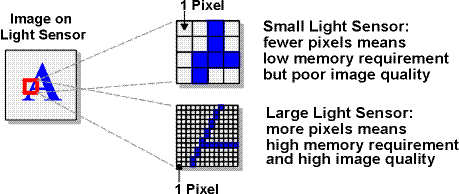NORDview: Digital Camera Imaging
Digital Camera Imaging
Digital Camera Components
A typical digital camera has the following major components:

The function of each component is as follows:
- Lens: focuses the image on the light sensor
- Light Sensors: an array of light sensitive elements that measure image brightness
- Analog-to-Digital Converter: converts the analog voltage from each light sensitive element into digital data representing the image of the photographed object
- Microprocessor: organizes the image data and stores it in memory, possibly using data compression
- Memory: storage for the microprocessor software and the photo data; additional data such as voice annotation or camera status may be appended to the photo data
- Viewing Device: a screen or view-finder displaying the image
- Camera Output: USB, Serial, IEEE-1394 (Firewire) or SCSI cable; IrDA wireless; Digital Film (i.e., Flash Memory Card), etc.
Photo File Size
The most noticeable variable among digital cameras is the light sensor. The light sensor used in most cameras is a semi-conductor chip called a CCD (charge-coupled device) that captures the image in a rectangular array of pixels (photo elements). The brighter the light entering a pixel of the CCD, the larger the digital values recorded for that pixel.
The number of light sensors in a camera determines its basic image resolution.

To fill a 600x800 pixel computer screen requires an array of 600 light sensors vertically by 800 light sensors horizontally.
- 600 pixels x 800 pixels = 480,000 light sensors
Since light sensors respond only to light intensity, not color, a set of light sensors is required for each of the 3 primary colors: red, green and blue.
- 480,000 light sensors x 3 colors = 1.44 million light sensors
Since many light sensor discern 256 brightness levels, 1 memory byte (1 byte can represent 256 different values) is required for each light sensor.
- 1.44 million light sensors x 1 byte per sensor = 1.44 million bytes of memory per photo
Resolution is more critical when the image is printed. If the 600 x 800 pixel photo described previously is printed by a 300 dot per inch (dpi) desktop color printer, the resulting print is,
- 600 x 600 pixels / 300 dpi = 2”x 2.6” print
If this photo is printed in a 1200 dpi magazine, the published print is too small to even be recognized.
To produce a standard 3.5”x5” snapshot print using a 300 dpi printer requires a 1050x1500 pixel image producing a 4.725 megabyte (MB) file. An 8”x10” print requires a 2400x3000 pixel image producing a 21.6MB file.
Digital cameras use data compression (e.g., JPEG) to reduce the photo’s memory requirements but at the expense of image quality. A 2:1 compression may still produces a good quality image and is often described as a high-resolution image. An 8:1 compression seriously degrades image quality and is often described as a low-resolution image. Returning to the 4.725MB file that produced a 3.5”x5” snapshot print, a camera with a 8 megabyte digital film (i.e., flash memory card) storage could therefore store either
- 1 uncompressed photo (1 x 4.725 MB = 4.725MB),
- 3 high-resolution compressed photos (3 x 4.725 MB / 2:1 = 7.1MB),
- 13 low-resolution compressed photos (13 x 4.725 MB / 8:1 = 7.7MB),
or combinations thereof.

© Copyright NORDview, Inc. 1998-2000. All rights reserved.
Return to the NORDview home page.



